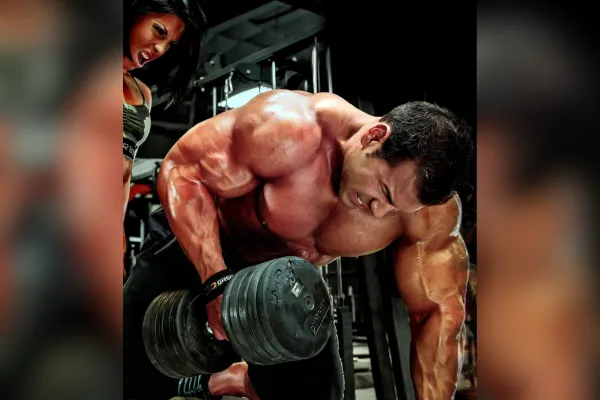
Progressive Overload - You're doing it wrong!
The term "progressive overload" is all the rage in the weight training world right now, but what exactly is progressive overload?
Most people consider progressive overload the act of getting stronger in a movement and leave it at that. If this is as far as you take the idea, you're going to hold yourself back in the long run.
In general....I look for any form of progressive increase in workload in my workouts--not just strength.
The problem with isolating "the amount of weight you lift" as the sole method of progressive overload is people focus too much on getting stronger in a lift rather than making a muscle stronger.
I can always add more weight to my squat by adjusting my stance, changing the bar position, finding weights I know are only 44.5lbs, wearing flatter shoes, using tighter knee wraps, or even resting a few seconds longer before my max set. Each of these training variations will lead to an increase in the amount of weight moved in that movement--but none of them are because my quadriceps actually got stronger.
In fact, I can use far LESS quad muscle involvement and actually lift heavier weight if I were to compare my squat poundages with a wide stance in flat soles, with the bar positioned low on my back vs. a high bar, close stance squat in olympic shoes.
If the goal is to get bigger quads by making them stronger, then the only way getting stronger in squats is a good indicator of that is if I change NO variables.
That means the same clothing, same bar, same weights, same form, same stance, same bar position, same meals, same exercise rotation, same warm ups, and same time between sets.
When you remove variables you find that the strength increases slow down dramatically...and a lot of the early (first many months) strength progression isn't getting stronger muscles, it's finding ways to be more biomechanically advantageous in a movement--and when you've maxed out all those things, then you're stuck with the true strength progression....which is much slower.
Because of that, I prefer to find any form of progressive overload.
If I can't get stronger or get more reps without changing variables, then I try to get the same weight for the same reps but with shorter rest periods. Or I try to complete the entire workout in a shorter time than the last one, or I try to find a way to do the last rep slower, or hold a static hold, or hold a final partial rep, or anything that is "more" than what I did the week before.
If I'm feeling strong, I'll go for a PR in weight/reps--but that isn't the only way to increase the workload on a muscle to produce results.
If I'm not feeling strong, I'll try to complete the same workout in less time than the previous week.
If I know I can't hit either of those goals, then I'll do the same number of reps, but then try for an extra rep and just hold it at the failing point as long as I can, or incorporate any number of intensity modifiers like drop sets, static holds, forced reps, super sets, or even giant sets.
Hell, if all else fails and I can't improve in ANY of those ways, there's always the option of performing an extra rep in each of my warm up sets.
If you want to continually progress in this sport you have to learn to think multi-dimensional in your training.

Progressive Overload - You're doing it wrong!
The term "progressive overload" is all the rage in the weight training world right now, but what exactly is progressive overload?
Most people consider progressive overload the act of getting stronger in a movement and leave it at that. If this is as far as you take the idea, you're going to hold yourself back in the long run.
In general....I look for any form of progressive increase in workload in my workouts--not just strength.
The problem with isolating "the amount of weight you lift" as the sole method of progressive overload is people focus too much on getting stronger in a lift rather than making a muscle stronger.
I can always add more weight to my squat by adjusting my stance, changing the bar position, finding weights I know are only 44.5lbs, wearing flatter shoes, using tighter knee wraps, or even resting a few seconds longer before my max set. Each of these training variations will lead to an increase in the amount of weight moved in that movement--but none of them are because my quadriceps actually got stronger.
In fact, I can use far LESS quad muscle involvement and actually lift heavier weight if I were to compare my squat poundages with a wide stance in flat soles, with the bar positioned low on my back vs. a high bar, close stance squat in olympic shoes.
If the goal is to get bigger quads by making them stronger, then the only way getting stronger in squats is a good indicator of that is if I change NO variables.
That means the same clothing, same bar, same weights, same form, same stance, same bar position, same meals, same exercise rotation, same warm ups, and same time between sets.
When you remove variables you find that the strength increases slow down dramatically...and a lot of the early (first many months) strength progression isn't getting stronger muscles, it's finding ways to be more biomechanically advantageous in a movement--and when you've maxed out all those things, then you're stuck with the true strength progression....which is much slower.
Because of that, I prefer to find any form of progressive overload.
If I can't get stronger or get more reps without changing variables, then I try to get the same weight for the same reps but with shorter rest periods. Or I try to complete the entire workout in a shorter time than the last one, or I try to find a way to do the last rep slower, or hold a static hold, or hold a final partial rep, or anything that is "more" than what I did the week before.
If I'm feeling strong, I'll go for a PR in weight/reps--but that isn't the only way to increase the workload on a muscle to produce results.
If I'm not feeling strong, I'll try to complete the same workout in less time than the previous week.
If I know I can't hit either of those goals, then I'll do the same number of reps, but then try for an extra rep and just hold it at the failing point as long as I can, or incorporate any number of intensity modifiers like drop sets, static holds, forced reps, super sets, or even giant sets.
Hell, if all else fails and I can't improve in ANY of those ways, there's always the option of performing an extra rep in each of my warm up sets.
If you want to continually progress in this sport you have to learn to think multi-dimensional in your training.
Upgraded Human News
Subscribe to our email list and be the first to hear about exclusive offers and updates.

